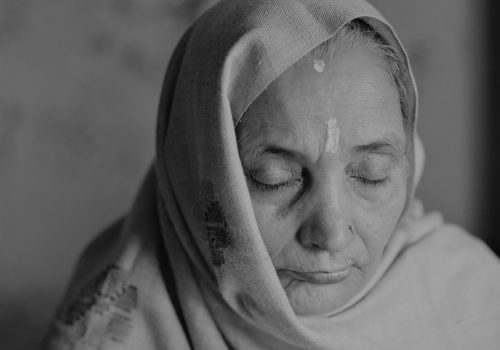Eternal Light, a series of photographs by Kenro Izu currently on view at Howard Greenberg Gallery in New York, radiates the spiritually of India, its traditions, festivals, and rituals, in a series of portraits and landscapes from 2013 through 2015. Two holy cities, Varanasi and Allahabad, inspired Kenro Izu, who has traveled to India frequently since his first visit 20 years ago. With a name that means “city of light,” Varanasi is considered the spiritual capital of India, a destination for pilgrimages and, for Hindus, the final destination for those who wish to be cremated along the Ganges. Allahabad is the holy city where three rivers meet. The confluence point of the Ganges, the Yamuna, and the Saraswati rivers – called Triveni Sangam – is sacred, and bathing there is said to flush away all of one’s sins.
Izu became immersed in Indian culture after receiving a rather unusual invitation in 1996. The artist was invited by a family in Varanasi to observe the cremation of a family member from beginning to end. The three-and-a-half hour ceremony took place by the Ganges. The body was covered in fabric and decorated with flowers and at the end nothing remained as the ashes were swept into the river. “It was an amazing experience. I was quite interested in the family’s attitudes. There was no weeping; only joking and laughing. It was so different from my culture,” notes Izu, who was born in Japan and moved to New York City in 1970.
In Eternal Light, Izu captures individual experiences of joy and suffering related to death and the afterlife. The Ganges and Yamuna rivers provide the setting for many of the images in the exhibition, and the photographs seemingly transcend earthly concerns. Often a thick fog envelops his subjects as family members mourn a life and birds flock over the river. In the city of Vrindavan, he photographed among the thousands of temples dedicated to Krishna, and finds unexpected vistas in the turn of an alley where a grand gate can lead to a rundown home for the poor.
Highly attuned to the emotions of his subjects, Izu meets countless widows in Vrindavan, which is known for housing them, sometimes for free, as these women are forced out of their families because it’s felt in India that the widow is cursed for outliving her husband. Moved by the plight of children in an orphanage, he writes in his new and eponymous book published by Steidl: “In their eyes I saw a brightness and sparkle that seemed to me to be the eternal light shining out.” He notices that another child in a white cloth “emanates a subtle light in twilight.” Izu concludes: “I have traveled numerous countries as if on a pilgrimage using my camera to find my Eternal Light. It’s as though the Hindu gods have suggested that I think about the question, ‘Where are people heading, in this life and after?’”
Kenro Izu, Eternal Light
October 26 – December 9, 2017
Howard Greenberg Gallery
41 E 57th St
New York, NY 10022
USA
http://www.howardgreenberg.com/
















